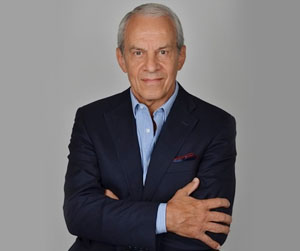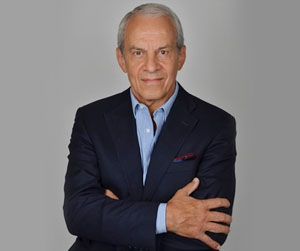Stomach surgery (abdominal plastic surgery)
Abdominal plastic surgery, or abdominoplasty, is intended for patients whose abdomen has slackened after pregnancy or significant weight variations.
The aim of the operation is to obtain a flat stomach by tightening the abdominal wall, removing excess skin and fat and, if necessary, by also repairing the muscular wall in the event of a hernia, eventration or sagging (diastasis).
Excess skin is usually removed from the area between the umbilicus and the pubis.
Excess fat is removed in two ways:
-
Fat is removed from under the skin in one block;
-
The fatty excess is removed by liposuction even outside the area of skin resection.
When this abdominal sagging is really significant and hangs on the pubis, we call it the "abdominal apron". It is a source of discomfort in daily life (irritations in the abdominal crease, perspiration, mycosis or eczema, difficulty wearing certain clothes, postural discomfort, back pain, etc.), but also a source of a feeling you have failed in your dieting efforts because the apron persists despite weight loss and seems to make your efforts in vain, which discourages patients. This means they are exposed to the risk of the yoyo phenomenon by gaining weight after having lost it.
Conversely, the operation can be motivating because your dieting efforts are rewarded by an overall slimmer figure.
This new sense of harmony is a balancing factor and boosts self-confidence, whether naked or clothed.
Uses
There are different types of abdominoplasty depending on the state of anatomical problems.
A small round belly with simple excess fat can be treated by abdominal liposuction.
A tummy with moderately sagging skin can be treated by liposuction combined with a short scar abdominoplasty (caesarean type) without touching the umbilicus.
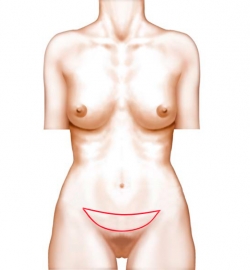
An abdominal apron with a large excess of skin and fat will require abdominoplasty with skin and fat resection (dermolipectomy) on the area between the umbilicus and the pubis. The scar is located in the lower abdominal fold and extends laterally to a certain length, depending on the extent of excess skin with, if necessary, a reconstruction of the muscle wall. The umbilicus is retained and repositioned normally with a scar located in the umbilicus.
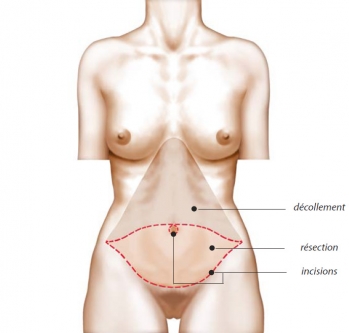
Each person arrives with a request for correction of a particular defect that is particularly troublesome to them. The objective of the operation will be to correct this defect as a priority by assessing whether it may be appropriate to correct other associated defects to have a well-balanced, natural result that meets expectations.
So, depending on the insights gained during the first consultation, the operation could possibly be combined with another intervention, in particular: liposuction, a thigh lift, arm lift, breast lift, breast augmentation using prosthetics or by lipofilling (injecting your own fatty tissue collected during abdominoplasty), or a pubis lift.
This can be carried out during the same operation or at another time, depending on the associated operation.
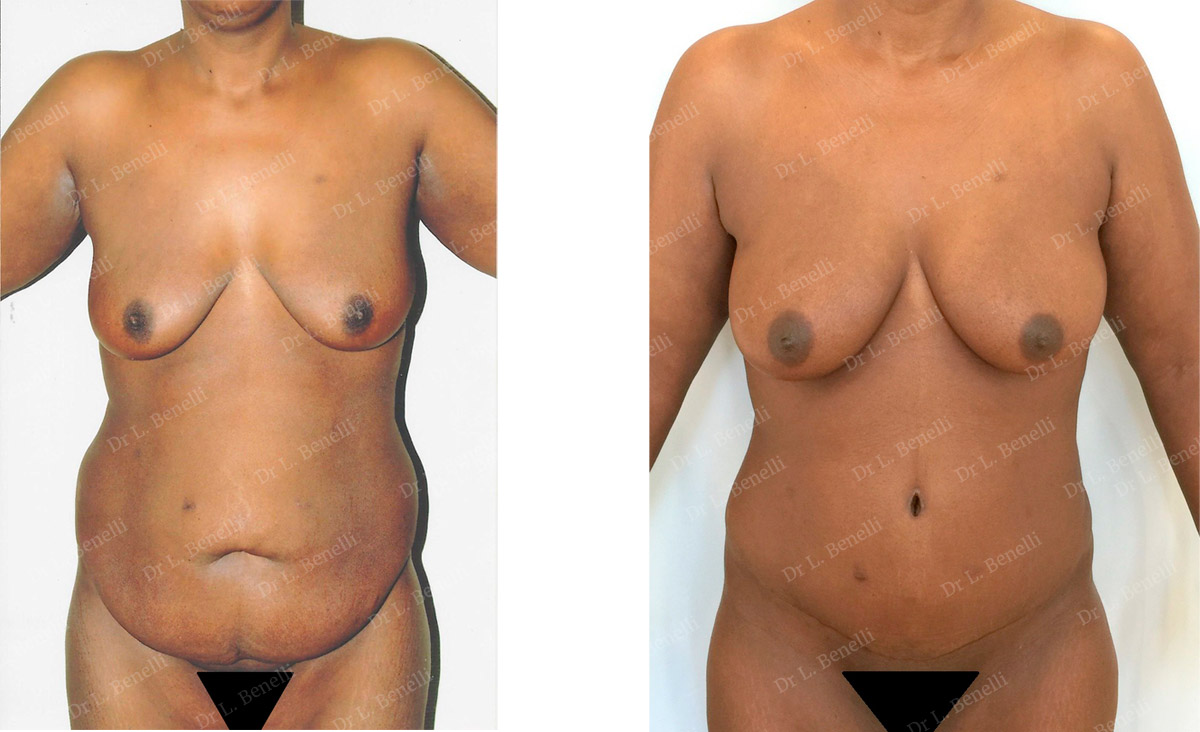
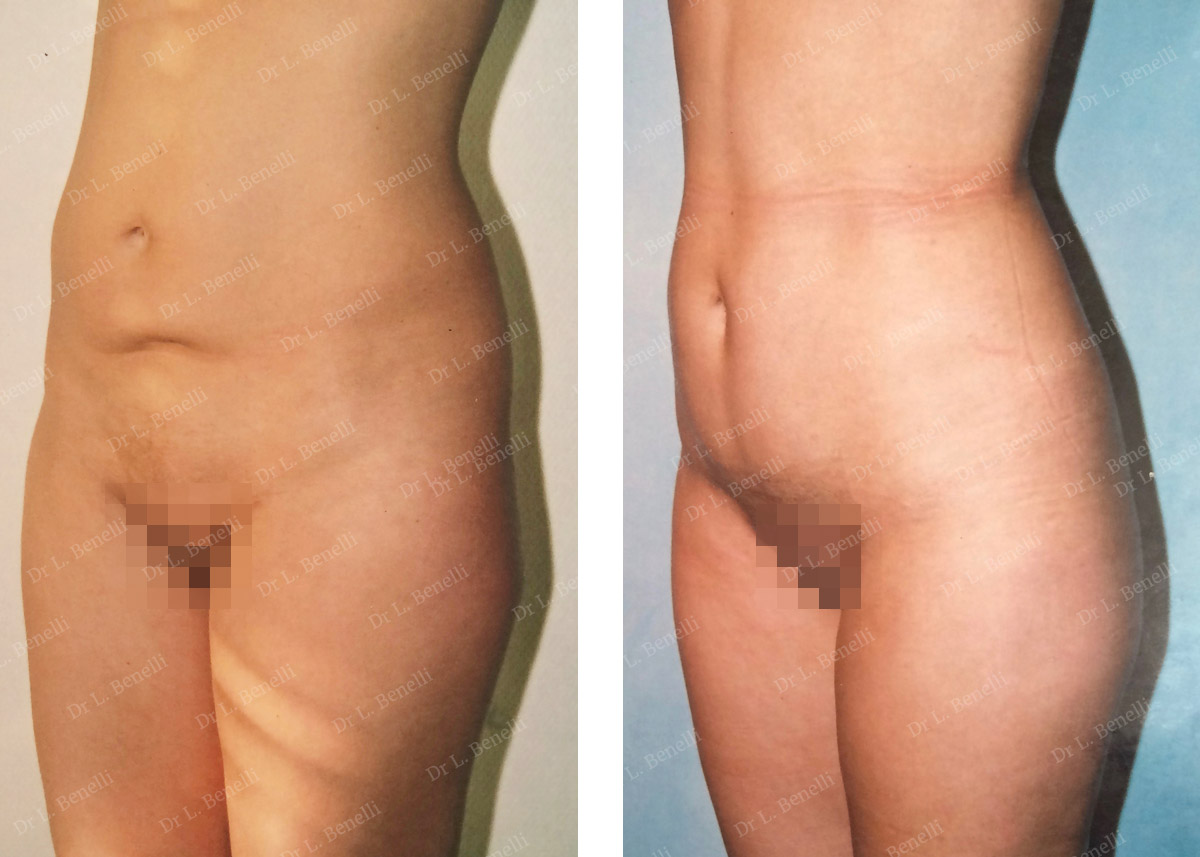
Caesarean scar resection by mini abdominal plastic surgery without umbilical transposition
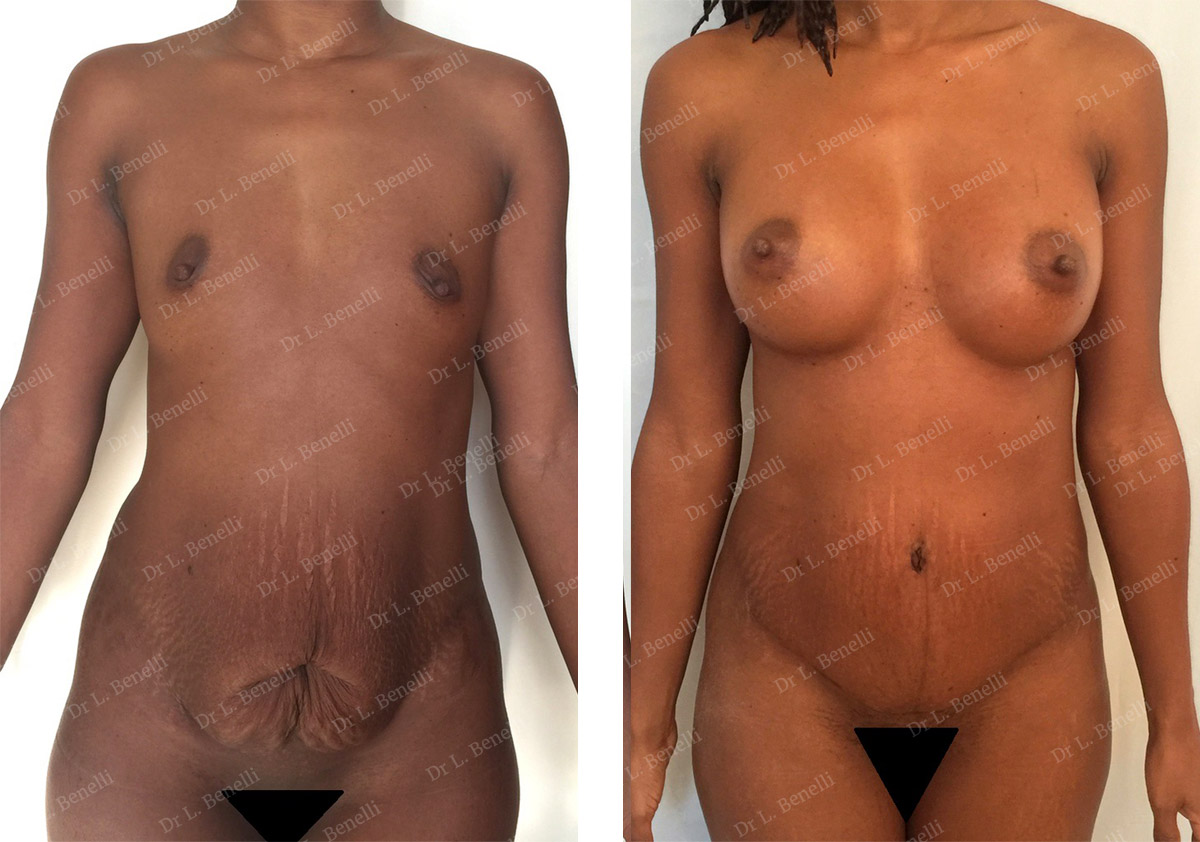
Abdominoplasty with umbilical transposition, eventration cured using muscle plasty and inserting anatomical breast prostheses through the axillary route
Consultation
During the first consultation, it is essential that you openly express what bothers you and what you would like to improve. Do not be afraid to ask any questions, including expressing your fears and expectations. Everyone has a different body shape, psychology and expectations. These are not the same and there is no standard to apply.
After you have explained your motivations, I will examine you and offer one or more solutions, taking into account your expectations, your anatomy, respecting your identity and the natural aspect of your appearance.
At the first consultation, I will evaluate the best technique to use, the location of the scars to tighten the abdominal wall, the locations to treat by liposuction and, if necessary by lipofilling.
So you can visualise the desired result, I will show you photos of surgical results from cases similar to yours to understand the objective of the intervention.
It is essential that you and I have a good understanding when deciding to operate and to determine the technique to use from among those I can offer.
I will then give you all the information on the techniques proposed along with the information sheets from the Société Française de Chirurgie Plastique Reconstructrice et Esthétique (French Society of Plastic, Reconstructive and Cosmetic Surgery) as well as a detailed estimate of the costs for the options chosen. You will then be able to move your project forwards and get ready for a second consultation when you will be able to ask any additional questions to help you make a decision and prepare for the operation.
Before the procedure
A blood test should be carried out.
If you have a hernia, associated eventration, or simple relaxation of the muscle wall (diastasis), an ultrasound of the abdominal wall should also be performed to assess the extent and exact location of the muscle wall defect.
For general anaesthesia, a consultation with the anaesthetist is necessary in the weeks before the operation and at least 48 hours before.
Pubic hair removal is necessary a few days before the operation.
You will need to buy a specific post-operative abdominal belt to support the area that has been operated on. It must be brought on the day of the operation to be put in place at the end of the operation.
Recommendations:
No medication containing aspirin or anti-inflammatories should be taken within 10 days of the procedure.
For general anaesthetic, you will have to fast strictly for 6 hours before the operation (do not eat anything, chew gum, eat sweets or smoke).
Tobacco consumption should be stopped or reduced as much as possible during the month before and month after the procedure. Tobacco can cause scarring problems.
The procedure
Hospitalisation and the duration of the procedure:
Your stay in hospital is generally 2 days. Same-day discharge is also possible after a few hours of monitoring following the operation. During the night, painkillers and analgesics are given by drip if you are in hospital or can be taken in tablet form at home.
The operation lasts from 1 to 3 hours.
Type of anaesthesia:
In most cases, the operation is performed under general anaesthesia.
Technique:
Before you go to the operating theatre, in your room, I will go over the precise goals with you that we agreed during the consultations. You can then always make recommendations and ask any questions. I will then draw the lines and marks on your skin to guide the operation and the lines of the incisions.
An incision is made in the lower abdominal fold, at the level of the pubic area, placed so it is hidden by a bathing suit. The length of the scar will depend on the excess skin to be removed.
The tissues above the umbilicus are repositioned towards the bottom on the suprapubic scar, the umbilicus is retained and repositioned normally with a scar inside the umbilicus.
If you have a hernia, associated eventration, or simple relaxation of the muscle wall (diastasis), it may be necessary to repair the muscle wall to restore integrity and tension.
Remodelling of the abdominal shape is completed by liposuction of the residual excess fat, particularly laterally on the hips and waist.
The stitches are placed within the skin’s thickness (inverted stitch and intradermal overlock) and are, therefore, invisible. These stitches are absorbable so they do not need to be removed.
Staples are sometimes used to complete the internal stitch, if necessary.
At the end of the operation, a compression dressing is applied to the scar and an abdominal belt is fitted.
After the operation
During the night and the days following the operation, there may be a painful sensation of tension in the area that was operated on, such as aches and pains, which may impede your mobility. These pains are moderate in a resting position and may require analgesics that are given by a drip during your stay in hospital or are taken as tablets at home. These post-operative pains will diminish and disappear within a few days of the operation.
You can walk the day after the operation.
Swelling (oedema) and bruising are generally moderate and it takes about ten days for these to disappear almost completely.
As the stitches used are absorbable, they do not need to be removed. Placed internally in the skin’s thickness (intradermal overlock), they are invisible. Any staples are removed within a week of the operation to avoid leaving a mark.
You will need to take time off work for 3 weeks in the majority of the cases.
Care:
-
The abdominal belt should be worn day and night for 1 month, especially in if you have had a hernia repair or eventration.
-
The scars should be cleaned after showering using an antiseptic, and if necessary, treated with ointment in the weeks and months following the operation to improve the quality of healing.
You will need to make a follow-up visit about a week after the procedure, then after 1 month, 3 months, 6 months, and 1 year.
Recommendations:
-
You can resume sporting activities as soon as the painful discomfort has subsided.
- Walking is highly recommended in the days following the operation because muscular activity promotes the drainage of the tissues that have been operated on and limits the risks of phlebitis.
-
Prolonged standing still is not recommended.
- The recommended rest position is lying on your back or side with your legs bent.
-
Exposure to the sun: No exposure while there are traces of bruising, even small. Then, exposure is possible using a sunscreen with a maximum sun protection factor.
-
As part of the shape of the abdomen, some of the volume comes from bloating to digestive organs. For the best result, it is important to have good food hygiene, if necessary with the advice of a nutritionist, to control this problem.
-
Pregnancy: it is advised to wait for 6 months before considering a pregnancy, so that the wound healing can complete and be as strong as possible. There are no contraindications to subsequent pregnancies, but it is recommended that you do not gain too much weight during pregnancy. This way, the result of abdominal plastic surgery is usually very long-lasting, even in the case of several post-operative pregnancies.
The result
The result of trimming down the figure is immediately visible despite post-operative oedema and will continue to improve in the weeks and months after the operation.
In the long term, tissue sagging is permanently corrected and the majority of patients do not need another operation, even if they have several post-operative pregnancies with controlled weight gain of less than 10kg.
The excess fat removed cannot return because the fat cells do not multiply. Any weight gain will be harmoniously spread over the whole body.
In addition to obtaining a flat stomach, the additional advantage of abdominal plastic surgery is the repositioning of the pubis and genital organs whose position is enhanced by tensioning the skin upwards, with potential fat reshaping of the pubis (pubic lift).
Moreover, the removal of the abdominal apron, which can prevent attempts at weight loss because it is resistant to dieting, encourages you to continue dieting, which is rewarded by a harmoniously slimmer figure.
In addition to an aesthetic improvement, this operation has a beneficial impact on personal well-being and weight control, and makes physical activity easier, especially if the muscle wall was deficient (hernia, eventration, diastasis) making muscle use painful.
Risks and complications
Price range
The cost of the operation will depend on the procedure to be carried out, the duration of the operation, the type of anaesthetic and any hospital charges.
If the reason for the operation is purely cosmetic, you cannot get any reimbursement through a Social Security claim. On the other hand, if the abdominal apron is large enough to cover the pubis, you may be covered by Social Security and, if necessary, by your mutual insurance company after prior agreement by the Medical Adviser of the Primary Health Insurance Fund. The same applies if the operation is for reconstruction after an accident or an illness.
A detailed estimate is given to you during the first consultation according to the options you have chosen. You then have a minimum legal period of 15 days to consider your options and move your project forward.
The first consultation costs €50. The follow-up consultations before and after the operation are free.
The photographs on this page are here to illustrate and complete the information given on the operations. They are merely for information purposes so you can see the goals, results and scars from the operation.
The likelihood of scarring, and each patient’s individual anatomy, are different. For this reason, therefore, the photographs on this site do not commit Dr. Benelli to providing all patients with a similar result.
The information given on a site is not sufficient in itself and a medical consultation is essential to get the right information for each individual case. For this, you will need to consult a surgeon qualified in Plastic Reconstructive and Aesthetic Surgery.
